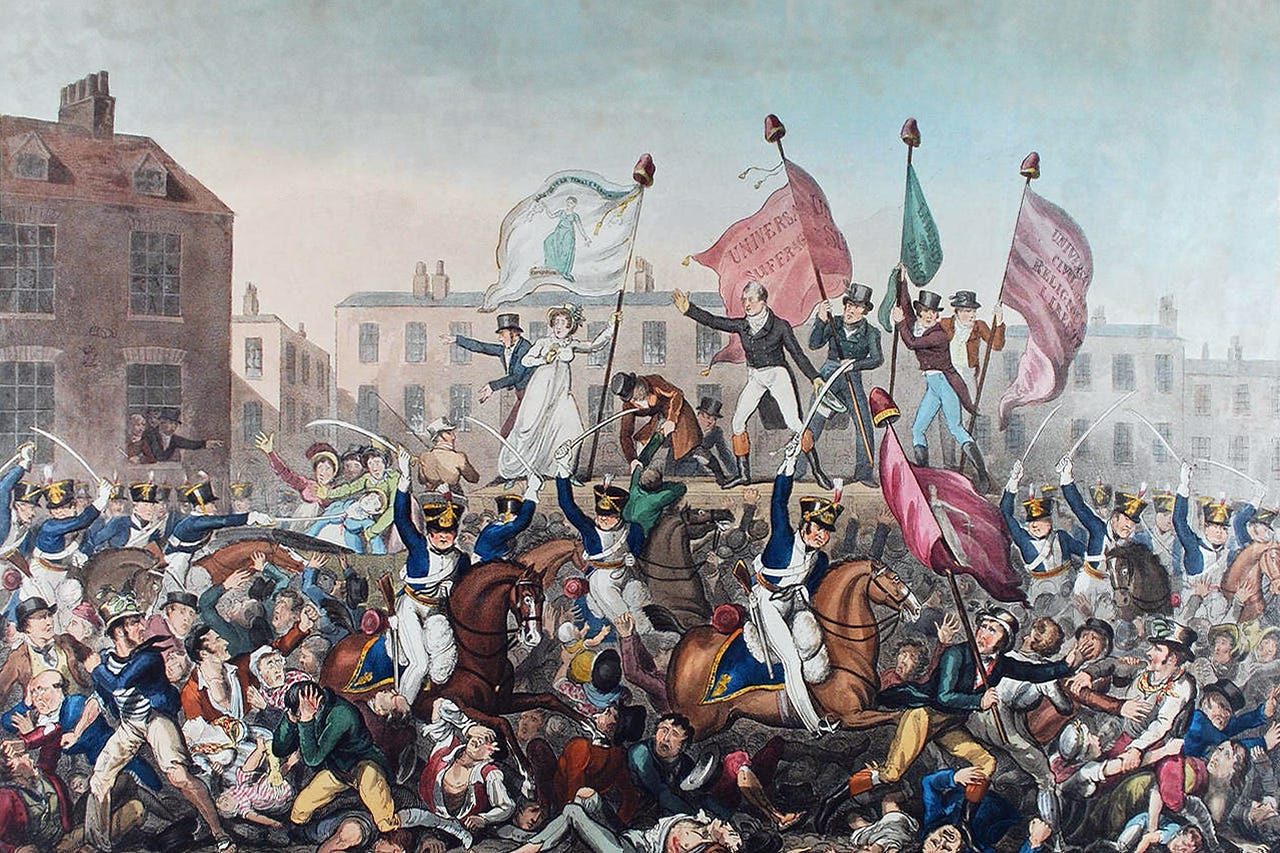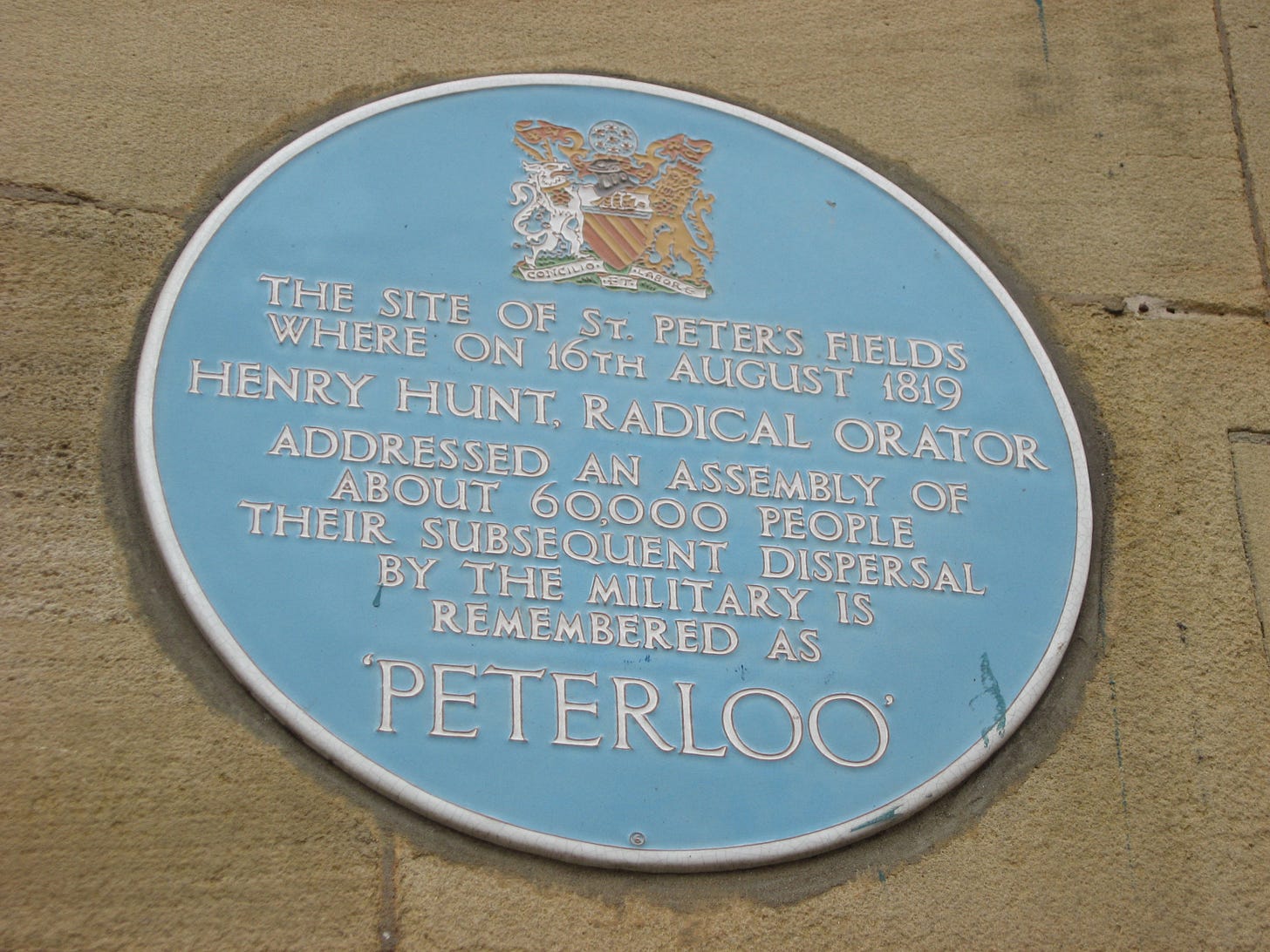Peterloo: The Massacre That Shook Britain
A peaceful protest turned to bloodshed in Manchester, 16 August 1819
On 16 August 1819, a crowd of over 60,000 people gathered peacefully on St Peter’s Field in Manchester to demand political reform. What began as a hopeful call for representation ended in horror when armed cavalry charged the unarmed crowd. At least 15 people were killed and hundreds were injured in what would come to be known as the Peterloo Massacre.
In the years following the Napoleonic Wars, Britain was struggling with economic hardship, high unemployment, and growing public unrest. Industrialisation had reshaped the north of England, especially Manchester, which had rapidly grown into a hub of manufacturing but lacked proper political representation.
At the time, only about 11% of men could vote, and entire industrial towns like Manchester had no Members of Parliament. The system was deeply unequal, favouring landowning elites and so-called “rotten boroughs” with barely any inhabitants.
Inspired by revolutionary ideas from France and America, and by the hunger for justice at home, campaigners began organising large public meetings to demand parliamentary reform.
On 16 August, reformers in Manchester organised what was intended to be a peaceful rally. People came from all over Lancashire—men, women, and children—dressed in their Sunday best. They carried banners calling for “Universal Suffrage”, “Equal Representation”, and “No Corn Laws” (a reference to the hated tariffs that kept food prices high).
The day’s key speaker was Henry Hunt, a radical orator known for his charismatic advocacy of peaceful reform. The crowd, estimated at over 60,000, gathered in good spirits under clear skies. It was one of the most significant political demonstrations ever seen on British soil up to that point.
Despite the peaceful atmosphere, local magistrates, watching from a nearby building, panicked. Fearing insurrection, they ordered the Manchester and Salford Yeomanry (a volunteer cavalry force composed mainly of local landowners) to arrest Hunt and disperse the crowd.
The cavalry charged recklessly into the tightly packed crowd, sabres drawn. Panic spread as people tried to flee. The 15th Hussars, a professional regiment, were soon called in to support the yeomanry. The result was chaos. In less than ten minutes, dozens lay dead or wounded, trampled by horses, slashed with sabres, or badly crushed.
Among the victims were women and children. 18-month-old William Fildes was reportedly killed when his mother was knocked down. Mary Fildes, president of the Manchester Female Reform Society, was among the many women injured.
The authorities called it a necessary act to preserve public order. However, the public and much of the press were horrified. The term “Peterloo Massacre” was coined by the radical Manchester Observer as a bitterly ironic nod to the Battle of Waterloo, which had occurred just four years prior.
Eyewitness accounts, pamphlets, and newspaper articles spread news of the atrocity. The radical press, including publications like The Manchester Observer and The Leeds Mercury, helped rally public anger.
Rather than reform, the government responded with repression. The Six Acts were passed, further limiting free speech, assembly, and the press.
Though it failed in the short term to bring about reform, the Peterloo Massacre became a symbol of the struggle for democracy in Britain. It galvanised future movements and was cited by campaigners for the Great Reform Act of 1832 and later the Chartist movement.
Today, Peterloo is remembered not only as a tragedy but as a turning point. A memorial stands in Manchester, commemorating the lives lost and the fight for civil rights. The event is now recognised as a pivotal moment in the history of British democracy, a reminder of the cost of freedom and the power of collective action.
CLICK HERE to read more History and Happenings articles.
In Just One Damned Thing After Another by Jodi Taylor, historian Peterson and trainee Kevin Grant travel back in time to witness the Peterloo Massacre. Read it now to learn more about this event and discover how they fared.




